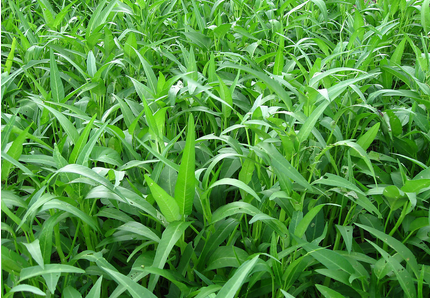The spinach is also known as bamboo leafy vegetables, amaranth, and rattan. It is native to southern China and India, and has a long history of cultivation in China. The tender stems and young leaves are used as edible organs. It is rich in nutrients, and it has the effects of relieving heat, cooling blood, diuresis, digestion and detoxification. It is suitable for fried food, soup and kimchi.
The spinach enjoys a warm and humid climate. The seeds can germinate above 15 °C, the seedlings grow at a suitable temperature of 25 °C, and the stems and leaves grow at a suitable temperature of 25-35 °C. The growth below 10 °C is stagnant, and the frosty stems and leaves are dead. The lighting requirements are not strict and are more resistant to shading. It is not drought-tolerant, and the yield is reduced when the water is too small. It has strong adaptability to the soil, but it is suitable for the cultivation of clay loam with strong fertilizer and water retention.

1. Seeding and seedling transplanting. Sowing in April-July. In the early spring, the method of spreading is used, and the broadcasting is carried out in a dense manner. The amount of seeds per mu is about 10 kg. General line or on-demand in summer. After sowing, it is covered with nails and loose soil, and 1500-2000 kg of manure per acre is used to cover the seed fertilizer, which can be emerged in about 1 week. The use of cold bed or small arch shed seedling can save seeds, go ahead in the market, plant in mid-to-late March, plant in mid-to-late April, seeding of 1 mu seedbed is about 20 kg, and can transplant 15-20 mu of field. Seedling height of about 20 cm can be pulled out of the market or planted. It can be used for vine or cutting propagation in wintering old plants or live seedlings. The row spacing of dryland plants is about 16 cm, and that of paddy fields is about 22 cm.
2. Field management.
(1) Cultivation in dry land. Choose a moist and fertile lowland, apply about 2,500 kilograms of high-quality organic fertilizer per acre. Temporary cultivating and weeding before closing the line. Always keep the soil moist. After emergence or transplanting, cutting and survival, the fertilizer will be topdressed once in a timely manner. After each 3-5 days, the fertilizer will be applied once every time. Each time, 1,500 kg of diluted manure water will be applied per acre, and it will be poured down the rows to reduce pollution. Fertilization should be carried out after each tillage.
(2) Paddy field cultivation. Choose irrigation and drainage, sunny, fertile, shallow muddy field planting. Generally, seedling transplanting or cutting propagation is carried out. Maintain a water depth of about 3 cm in the early stage of growth to improve soil temperature. After entering the vigorous growth period, maintain a water layer of about 8 cm to meet the transpiration of plants and accelerate growth. Topdressing is mainly based on quick-acting nitrogen fertilizer such as decomposed manure, first light and then concentrated, and once harvested once.
(3) Floating culture. The mud layer is thick, fertile, and the water surface is 30 cm or more. In May and May, the leek seedlings or pruning were clipped with ropes, bamboo branches, etc., stocked in water and fixed with wooden stakes. Basically no fertilizer and water management.
3. Pest control. The main pests are Plutella xylostella, red spider, aphid, etc., and can be controlled by high-efficiency and low-toxic pesticides such as imidacloprid and azadirachtin. Common diseases are white rust, which can be sprayed with Bordeaux or Daisen zinc.
Fingerprint Lock Safe Box,Fingerprint Lock Safe,Fingerprint Lock Box,Fingerprint Safe
Hebei Tiger Brand Group Jia Bao Cabinet Industry Co. LTD , https://www.cntigersafe.com